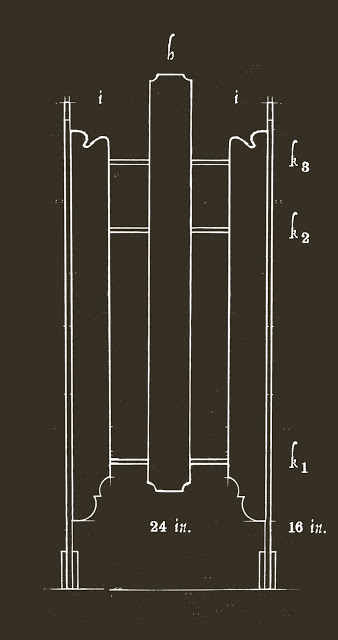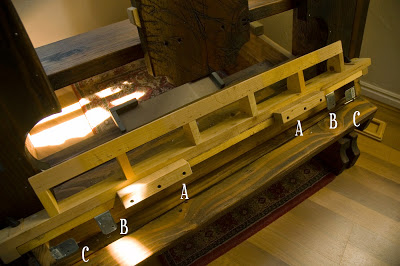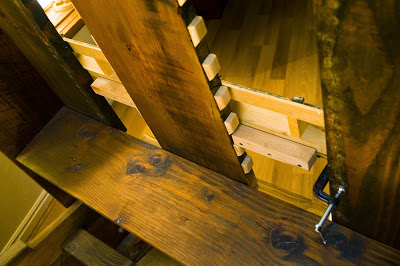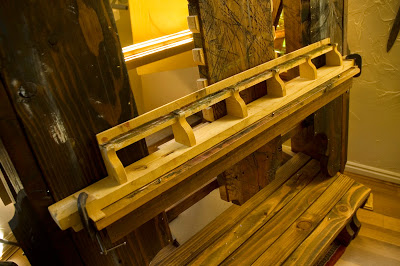Tray and trestle for the $10 easel
By Al R. Young
The tray (ledge) used on the $10 easel is secured to the easel by means of C-clamps that hold it in place against the vertical 2x10s (i) in the following diagram.
 |
The next photograph presents the back of the easel with the tray in place and shows how the 2x2 blocks (at A in the foregoing photo) interact with the wooden sprockets lining both sides of the vertical 2x12 in the middle of the easel.
The reason for adding the sprockets to the back of the tray arose from the difficulty associated with holding in place the tray while trying to keep it level and tighten the C-clamps that secure it to the 2x10s. The sprockets keep the tray level and in place while the C-clamps are tightened.
The final photo shows the trestle on which the painting rests. The reason for the trestle is to allow for minimal restraint upon brush-holding and manipulation along the bottom of the painting. For example, pushing a panel to the back of a deep tray gets in the way of holding a brush vertically against the bottom of the panel. Of course, a panel can be scooted to the front of the tray, which is why the three ball-headed screws in the photograph are positioned along the front edge of the tray; nevertheless, I like the stability of the trestle, which keeps the entire panel securely against the face of the easel.
Browse articles by year: 2025 . 2024 . 2023 . 2022 . 2021 . 2020 . 2019 . 2018 . 2017 . 2016 . 2015 . 2014 . 2013 . 2012 . 2011 . 2010 . 2009 . 2008 . 2007 . 2006 . 2005 . 2004 . 2003 . 2002 . 2001 . 2000 . 1999 . 1998 . 1997 . 1996
Browse articles by topic: Art lessons . BenHaven Archives . Blank art diaries . Fine art photography . Framing . Illustration . Inspiration and creativity . Isles of Rune . Limited Editions Collection . My Fathers Captivity . News . Novellas . Oil paintings and prints . Operations announcements . Orders and shipping . Overview . Portfolios . The Papers of Seymore Wainscott . Project commentaries . Recipes by Nancy Young . Recommended reading . Recommended viewing . Temple artworks . The Storybook Home Journal . Tips and techniques . Tools supplies and operations
Browse articles by topic: Art lessons . BenHaven Archives . Blank art diaries . Fine art photography . Framing . Illustration . Inspiration and creativity . Isles of Rune . Limited Editions Collection . My Fathers Captivity . News . Novellas . Oil paintings and prints . Operations announcements . Orders and shipping . Overview . Portfolios . The Papers of Seymore Wainscott . Project commentaries . Recipes by Nancy Young . Recommended reading . Recommended viewing . Temple artworks . The Storybook Home Journal . Tips and techniques . Tools supplies and operations


